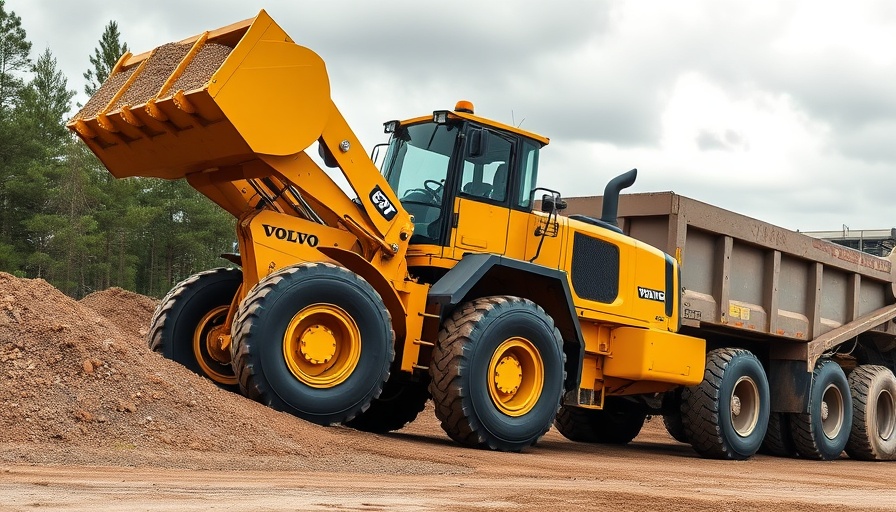
Volvo Rolls Out Next-Gen Large Wheel Loaders with Enhanced Features
Volvo Construction Equipment (CE) is set to redefine efficiency in the construction industry with its complete overhaul of large wheel loaders, which includes five new models slated for release in 2025: L150, L180, L200 High Lift, L220, and L260. With weights ranging from 53,131 to 85,980 pounds and horsepower ratios of 299 to 414, these loaders promise to deliver significant improvements in performance and functionality.
Why This Redesign Matters
Recently unveiled at the World of Asphalt event, particularly with the spotlight on the L260 model, this redesign is part of a broader strategy by Volvo CE to enhance their product line, following significant updates to their excavators and articulated dump trucks. Product manager Eric Yeomans emphasizes the need for this innovation as the company strives to cater to the evolving needs of their customers, showcasing a commitment to enhancing productivity and reducing operational costs.
Next-Level Technology to Boost Productivity
The next-gen wheel loaders are equipped with cutting-edge technology aimed at streamlining operations on-site:
- New Load-Sensing Hydraulics: This upgrade allows for faster lifting and lowering capabilities, providing operators with improved responsiveness.
- Automatic Bucket Leveling: This function assists in achieving the right angle for both dumping and curling, minimizing manual adjustments.
- Auto Bucket Fill: Optional feature that automates the throttle and hydraulics for precise bucket fills, enhancing overall efficiency.
- Smart Control: The default fuel-efficient engine mode activates automatically upon start-up, reducing fuel consumption by up to 4% without sacrificing productivity.
- Load Assist: This feature includes on-board weighing, operator coaching, tire-pressure monitoring, and a new load ticket function to facilitate invoicing.
Enhanced Performance Features
Volvo CE's new range of wheel loaders operates using the D13J engine, which works in sync with the Volvo transmission and axles, resulting in improved efficiency and stability. One significant advancement is the enhanced torque output that allows better performance at lower speeds. This feature, along with reduced gear-step intervals, promotes faster acceleration and smoother operations, particularly beneficial in multi-tasking scenarios typical in construction.
Introducing OptiShift: A Game Changer for Operators
The inclusion of Volvo OptiShift technology represents another leap forward, targeting reduced fuel consumption while maximizing loading cycles. This system utilizes Volvo’s Reverse by Braking function, which provides smoother transitions between forward and reversing without stressing the torque converter, enhancing operator comfort. The design caters to short-cycle loading tasks, which significantly boosts overall operational efficiency.
Future Trends in Construction Equipment
As construction equipment continues to evolve, the new features and upgrades introduced by Volvo CE set a benchmark for competitors. This shift towards smarter technology in machinery aligns with industry trends that prioritize automation and efficiency. Staying informed about these advancements not only helps contractors make better purchasing decisions but also ensures they remain competitive in a fast-paced market.
What This Means for Contractors and Homeowners
For homeowners and contractors alike, understanding these technological enhancements can lead to more informed decisions when it comes to selecting machinery for projects. Drive efficiency, enhance productivity, and minimize downtime with the latest equipment innovations. The sheer weight and horsepower provided by these next-gen loaders allow for versatility, whether you're dealing with heavy lifting, landscaping, or road construction, giving contractors the edge needed to deliver projects on time.
As Volvo gears up for the launch of these game-changing wheel loaders, it's clear that the construction landscape is poised for a major transformation. Homeowners and contractors should stay abreast of these developments to leverage the benefits that come with such advanced machinery.
In conclusion, Volvo CE's next-gen large wheel loaders are more than just machinery; they're a pivotal advancement in construction technology that promises to enhance productivity across the board. Prepare yourself for the changes they bring, and ensure your projects capitalize on what these innovations offer.
 Add Row
Add Row  Add
Add 




Write A Comment